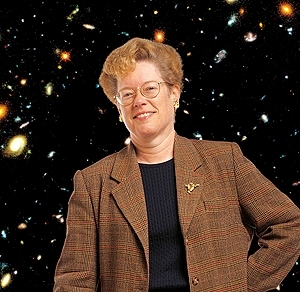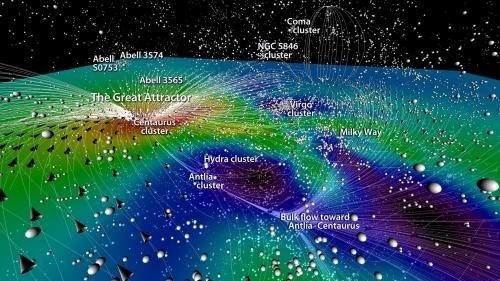Sandra Moore Faber was born December 28th, 1944 in Boston, Massachusetts. She was the daughter to Donald Edwin and Elizabeth Mackenzie. Her father was an insurance executive whom pursued the sciences in his spare time. While her mother was a housewife, with an interest in medicine. Faber recounts becoming interested in astronomy when she was out stargazing with her father. Faber was influenced by scientific literature such as The Stars in Their Course and Frontiers of Astronomy.
In later years Sandra continued to pursue her interest in the sciences. She attended Swarthmore College in Pennsylvania in which she obtained a BA degree in physics in 1966. Sarah Lee Lippincott was Sandra's mentor. Despite being an astronomer she wasn't part of the university faculty, this was because she lacked a doctoral degree. Through this observation Faber became determined to obtain one. She later attended Harvard University in order to obtain her Ph.D in astronomy in 1972. She did her residency at the Department of Terrestrial Magnetism, where she worked alongside Vera Cooper Rubin and Kent Ford. Sandra completed her doctoral thesis on elliptical galaxies, she was offered the position as assistant professor and astronomer at the Lick Observatory at the University of California.
 |
| Sandra Faber, with the Hubble Deep Field. (http://news.ucsc.edu/2009/02/2739.html (Photo by R. R. Jones)) |
The work she conducted at the observatory led to her to become interested in the formation, structure, and evolution of galaxies. With this in mind she worked alongside a fellow graduate student named Robert Jackson to develop the Faber-Jackson relation. This theory spoke of the size of elliptical galaxies to the speeds of their stars. Later in 1977, Faber was promoted to associate professor of astronomy at the Lick Observatory. In two years' time she would a full professor. In 1979 she and a fellow colleague wrote a review in which they concluded that galaxies are surrounded by pockets of invisible matter. It brought Faber and other scientist to propose that galaxies were made from this "invisible" matter. This initial review became the institution for the theory of dark matter in 1984.
 |
| The Great Attractor (http://www.dailygalaxy.com/my_weblog/2013/06/the-g (NASA)) |
Though Faber had already contributed important advances in astronomical studies, she continued to further the understanding of the universe into the early 1980's. Faber and six other astronomers were on a team project named, Seven Samurai Project. This project involved the measurement of distances and velocities of elliptical galaxies. This team project led to the 1990 discovery of the great attractor. As explained from the book, Scientist: Their Lives and Works, "A concentrated "galaxy of clumped galaxies" and matter that exerts a steady gravitational pull on an area of space approximately 100,000 light-years across, the great attractor includes our own Milky Way." In other words there is a great attractor somewhere in space that is pulling in galaxies at a speed of 400 miles per second (250 of which the Seven Samurai identified). Because of her many advancements of the theory of galaxy evolution, Faber was presented with the Dannie Heineman Prize for astrophysics by the American Astronomical Society and the American Institute for Physics in 1985. The next year she received an honorary doctorate from Swarthmore College. As well as being one of the few women to have become a member of the National Academy of Sciences. She is also a member of the wide-field camera design team for the Hubble Space Telescope. And currently she resides in California and as of August 1, 2012 she became the Interim Director of the University of California Observatories.
Both Annie Jump Cannon and Sandra Moore Faber were two women who brought advance understandings to the universe and its various components. Though Faber didn't work directly with stars like Cannon did, she worked with galaxies which is comprised of stars. These two women brought up more complex understandings to present research in their times. Cannon simplified the classifications of stars that continues to be used and Faber presented the concept of dark matter and the great attractor. Despite these women working in two different areas of astronomies their discoveries are driving us closer to understanding the universe. These two women were born during times in which women astronomers weren't highly regarded. Annie Jump Cannon herself faced discrimination for being deaf and was never voted to be the first woman astronomers to the National Academy of Sciences. What it seemed to me as that they strived to beat the odds and show their intelligence in a world where men were dominating all sorts of fields.In order to continue to inform people of these two women and their contributions to astronomy, I would continue to speak of them to people. I would bring up their names each time a woman is discredited for not having contributed enough to society. I would even possibly go as far as continuing their work, as I have an interest in astronomy. Speaking of these two women for many years even after Faber has passed would continue their legacy and not allow the people to forget their discoveries. They cannot be forgotten because every future theory on galaxies, stars, and dark matter are thanks to them they're part of a branch on a tree that continues to grow leaves to advance their finding even further.
Page created on 4/1/2016 12:00:00 AM
Last edited 4/1/2016 12:00:00 AM
Tenn, Joesph S. "The Bruce Medalists: Sandra M. Faber." [Online] Available http://www.phys-astro.sonoma.edu/brucemedalists/Faber/index.html.
Cengage Learning, Gale. Scientists: Their Lives and Works. Detroit: UXL, 2006.
Carnegie Institution. "Sandra M. Faber." [Online] Available https://carnegiescience.edu/trustee/sandra-m-faber.
